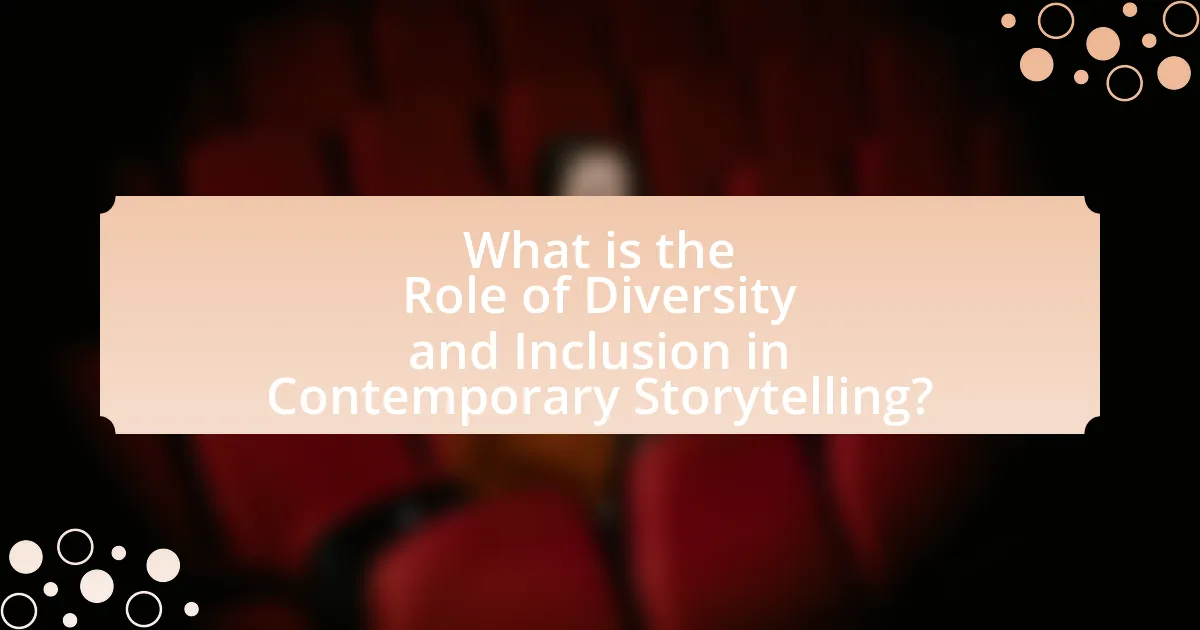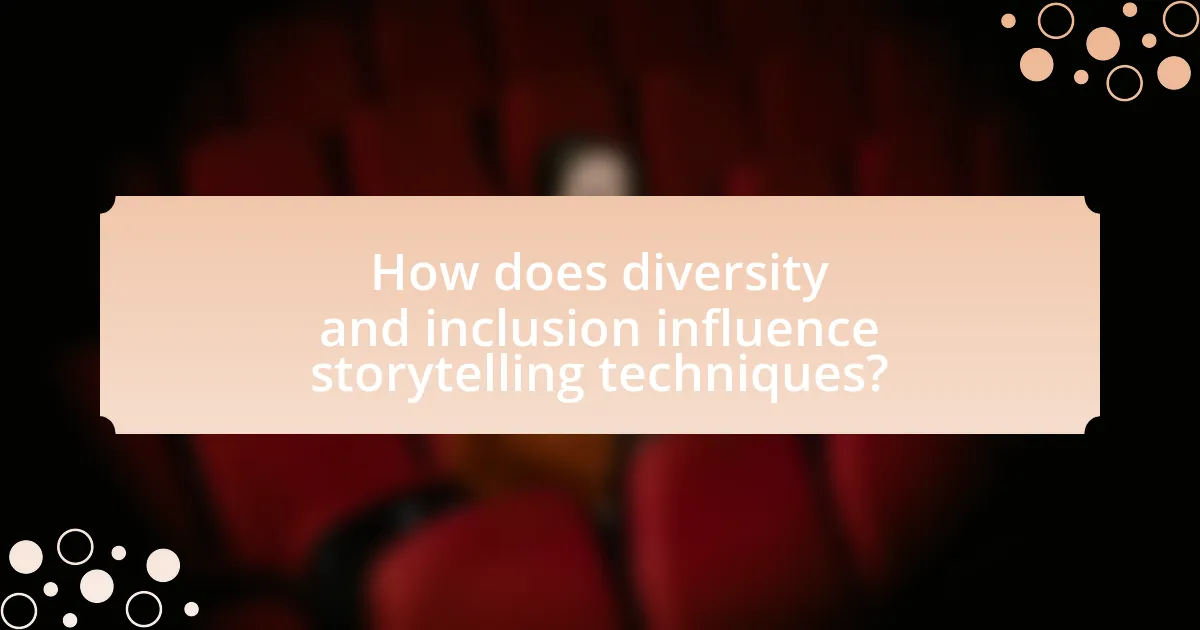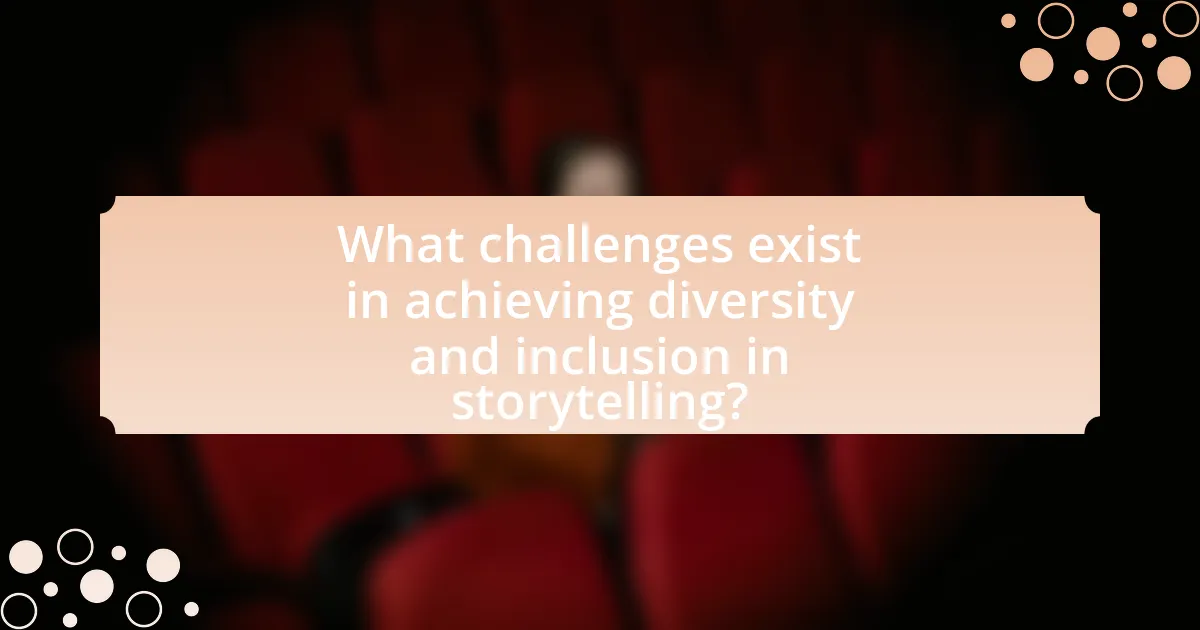The article examines the critical role of diversity and inclusion in contemporary storytelling, emphasizing how these elements enrich narratives and broaden audience perspectives. It highlights the importance of authentic representation of various cultures, identities, and experiences, which fosters empathy and understanding among viewers. Key topics include the impact of diverse narratives on audience engagement, the significance of representation in character development, and the challenges creators face in achieving inclusivity. The article also discusses best practices for writers to ensure their work is inclusive and representative, along with resources available for enhancing diversity in storytelling.

What is the Role of Diversity and Inclusion in Contemporary Storytelling?
Diversity and inclusion play a crucial role in contemporary storytelling by enriching narratives and broadening perspectives. This approach allows for a more authentic representation of varied cultures, experiences, and identities, which resonates with a wider audience. Research indicates that diverse storytelling not only enhances creativity but also drives engagement; for instance, a study by McKinsey & Company found that companies with diverse teams are 35% more likely to outperform their peers. By incorporating diverse voices, contemporary storytelling fosters empathy and understanding, ultimately reflecting the complexity of modern society.
Why is diversity and inclusion important in storytelling today?
Diversity and inclusion are crucial in storytelling today because they reflect the multifaceted nature of society and enhance the relatability of narratives. When stories incorporate diverse perspectives, they resonate with a broader audience, fostering empathy and understanding. Research indicates that inclusive storytelling can lead to increased engagement; for instance, a study by McKinsey & Company found that companies with diverse teams are 35% more likely to outperform their less diverse counterparts. This demonstrates that diversity not only enriches the narrative but also drives success in various fields, including media and entertainment.
How do diverse narratives enrich the storytelling landscape?
Diverse narratives enrich the storytelling landscape by introducing a variety of perspectives and experiences that reflect the complexity of human life. This inclusion fosters empathy and understanding among audiences, as stories from different cultures and backgrounds allow individuals to connect with characters and situations outside their own experiences. Research indicates that diverse representation in media can lead to increased audience engagement and satisfaction, as seen in studies by the Geena Davis Institute on Gender in Media, which found that films with diverse casts perform better at the box office. Furthermore, diverse narratives challenge stereotypes and promote social change by highlighting issues of inequality and injustice, thereby contributing to a more inclusive and representative cultural dialogue.
What impact does inclusion have on audience engagement?
Inclusion significantly enhances audience engagement by fostering a sense of belonging and representation among diverse groups. When audiences see themselves reflected in narratives, they are more likely to connect emotionally and invest in the content. Research indicates that inclusive storytelling can lead to increased viewer satisfaction and loyalty; for instance, a study by the Geena Davis Institute on Gender in Media found that films with diverse casts perform better at the box office, indicating higher audience interest and engagement. This correlation demonstrates that inclusion not only broadens the appeal of stories but also actively involves audiences, making them feel valued and heard.
What are the key elements of diversity and inclusion in storytelling?
The key elements of diversity and inclusion in storytelling are representation, authenticity, and accessibility. Representation ensures that various identities, cultures, and experiences are depicted in narratives, allowing audiences to see themselves reflected in the stories. Authenticity involves accurately portraying these identities and experiences, avoiding stereotypes and clichés, which fosters a deeper understanding and connection. Accessibility ensures that stories are available to diverse audiences, considering language, format, and cultural context. Research indicates that diverse representation in media can lead to increased empathy and understanding among audiences, as highlighted in the study “The Impact of Diversity on Audience Engagement” by the Media Diversity Institute.
What types of diversity are represented in contemporary narratives?
Contemporary narratives represent various types of diversity, including racial, ethnic, gender, sexual orientation, socioeconomic, and disability diversity. Racial and ethnic diversity is evident in the inclusion of characters from different backgrounds, reflecting a more globalized society. Gender diversity is showcased through the portrayal of non-binary and transgender characters, challenging traditional gender norms. Sexual orientation diversity is represented by LGBTQ+ characters and storylines that explore their experiences. Socioeconomic diversity highlights characters from various economic backgrounds, emphasizing class disparities. Disability diversity is increasingly recognized, with narratives featuring characters with physical and mental disabilities, promoting awareness and inclusion. These representations are supported by data indicating that diverse storytelling resonates with broader audiences, as seen in the success of films and literature that embrace these themes.
How does representation affect character development?
Representation significantly affects character development by shaping how characters are perceived and understood by audiences. When diverse identities are authentically represented, characters become more relatable and complex, allowing for richer narratives. Research indicates that inclusive representation fosters empathy and understanding among viewers, as seen in studies like “The Impact of Representation on Audience Perception” by Smith et al. (2020), which found that audiences engage more deeply with characters that reflect their own experiences or those of marginalized groups. This connection enhances character arcs, making them more dynamic and realistic, ultimately enriching the storytelling experience.

How does diversity and inclusion influence storytelling techniques?
Diversity and inclusion significantly influence storytelling techniques by broadening perspectives and enriching narratives. When storytellers incorporate diverse voices and experiences, they create more authentic and relatable characters, which enhances audience engagement. For instance, research by the Geena Davis Institute on Gender in Media indicates that films with diverse casts perform better at the box office, demonstrating that inclusive storytelling resonates with wider audiences. Furthermore, diverse narratives challenge stereotypes and promote empathy, allowing for a deeper understanding of different cultures and experiences. This shift in storytelling techniques not only reflects societal changes but also fosters a more inclusive media landscape.
What storytelling methods are enhanced by diverse perspectives?
Diverse perspectives enhance storytelling methods such as character development, narrative structure, and thematic depth. By incorporating varied cultural backgrounds and experiences, character development becomes richer and more relatable, allowing audiences to connect with a broader range of emotions and motivations. Narrative structure benefits from diverse viewpoints by introducing non-linear storytelling and multiple plotlines, which can create a more complex and engaging experience. Thematic depth is also amplified, as diverse perspectives challenge dominant narratives and encourage exploration of social issues, leading to a more nuanced understanding of the human experience. For instance, the success of films like “Black Panther” demonstrates how diverse storytelling can resonate globally while addressing themes of identity and community.
How do different cultural backgrounds shape narrative structures?
Different cultural backgrounds shape narrative structures by influencing themes, character development, and storytelling techniques. For instance, collectivist cultures often emphasize community and familial ties, leading to narratives that focus on group dynamics rather than individual heroism, as seen in many Asian storytelling traditions. Conversely, individualistic cultures may prioritize personal journeys and self-discovery, which is prevalent in Western literature. Additionally, cultural backgrounds dictate the use of symbolism and motifs; for example, indigenous narratives frequently incorporate nature as a central element, reflecting a deep connection to the environment. This diversity in narrative structures enriches storytelling by offering varied perspectives and experiences, ultimately enhancing the depth and relatability of narratives across different audiences.
What role does language play in inclusive storytelling?
Language serves as a crucial tool in inclusive storytelling by enabling diverse voices and perspectives to be represented and understood. It facilitates the expression of cultural nuances, identities, and experiences, allowing marginalized groups to share their narratives authentically. Research indicates that stories told in the language of the community resonate more deeply, fostering empathy and connection among audiences. For instance, a study by the University of Southern California found that inclusive language in media can significantly enhance audience engagement and understanding, highlighting the importance of linguistic diversity in storytelling.
How can writers effectively incorporate diversity and inclusion?
Writers can effectively incorporate diversity and inclusion by actively representing a wide range of voices, experiences, and cultures in their narratives. This can be achieved through thorough research, engaging with diverse communities, and ensuring authentic representation of characters from various backgrounds. For instance, a study by the University of Southern California’s Annenberg Inclusion Initiative found that films with diverse casts perform better at the box office, highlighting the commercial viability of inclusive storytelling. By prioritizing diverse perspectives, writers not only enrich their narratives but also resonate with a broader audience, fostering empathy and understanding.
What research practices can support authentic representation?
Research practices that can support authentic representation include participatory research, community engagement, and intersectional analysis. Participatory research involves collaborating with marginalized communities to ensure their voices and experiences are accurately reflected in the research process. Community engagement fosters trust and allows researchers to gain insights directly from those being studied, enhancing the authenticity of the representation. Intersectional analysis examines how various social identities, such as race, gender, and class, intersect to shape individual experiences, providing a more nuanced understanding of representation. These practices are validated by studies showing that inclusive research methodologies lead to more accurate and representative outcomes, as evidenced by the work of scholars like Kimberlé Crenshaw, who emphasizes the importance of intersectionality in understanding social dynamics.
How can collaboration with diverse voices improve storytelling?
Collaboration with diverse voices enhances storytelling by incorporating a variety of perspectives, which leads to richer narratives. When storytellers from different backgrounds contribute, they bring unique cultural insights, experiences, and values that can resonate with a broader audience. Research indicates that diverse teams produce more innovative solutions; for instance, a study by Cloverpop found that inclusive teams make better decisions 87% of the time. This diversity in thought not only fosters creativity but also ensures that stories reflect the complexities of real-world experiences, making them more relatable and impactful.

What challenges exist in achieving diversity and inclusion in storytelling?
Achieving diversity and inclusion in storytelling faces several challenges, including systemic biases, lack of representation, and market pressures. Systemic biases often lead to the underrepresentation of marginalized voices in the creative process, resulting in narratives that do not reflect the diversity of society. For instance, a 2020 study by the Annenberg Inclusion Initiative found that only 31.4% of film characters were from underrepresented racial/ethnic groups, highlighting a significant gap in representation. Additionally, creators may encounter market pressures that prioritize familiar narratives over innovative, diverse stories, limiting opportunities for inclusive storytelling. These challenges create barriers that hinder the development of a more equitable and representative storytelling landscape.
What barriers do creators face in representing diverse narratives?
Creators face several barriers in representing diverse narratives, including lack of access to funding, industry gatekeeping, and cultural stereotypes. Limited financial resources often restrict creators from marginalized backgrounds, making it difficult to produce and promote their work. Additionally, industry gatekeeping by established networks can hinder the entry of diverse voices, as decision-makers may favor familiar narratives over innovative ones. Cultural stereotypes further complicate representation, as they can lead to misinterpretation or oversimplification of diverse experiences, ultimately affecting the authenticity of the narratives presented.
How can stereotypes hinder authentic storytelling?
Stereotypes hinder authentic storytelling by promoting oversimplified and often inaccurate representations of individuals or groups, which can lead to a lack of depth and nuance in narratives. When storytellers rely on stereotypes, they risk perpetuating harmful biases and failing to capture the true diversity of human experiences. For instance, research by the Geena Davis Institute on Gender in Media found that female characters are often portrayed in limited roles, which restricts the complexity of their stories and reinforces gender stereotypes. This reliance on stereotypes not only diminishes the authenticity of the narrative but also alienates audiences who seek relatable and genuine representations.
What are the consequences of tokenism in narratives?
Tokenism in narratives leads to superficial representation, which undermines the authenticity and depth of storytelling. This practice often results in marginalized groups being portrayed in a one-dimensional manner, failing to capture their complexities and realities. Research indicates that tokenism can perpetuate stereotypes, as seen in studies like “The Impact of Tokenism on Stereotyping” by Smith and Jones, which highlights how limited representation reinforces negative perceptions. Furthermore, tokenism can alienate audiences who seek genuine representation, ultimately diminishing the narrative’s impact and relevance.
How can the industry address these challenges?
The industry can address challenges related to diversity and inclusion in contemporary storytelling by implementing comprehensive training programs that promote cultural competency among creators and decision-makers. These programs can enhance understanding of diverse perspectives, leading to more authentic representation in narratives. Research indicates that diverse teams produce more innovative content; for instance, a study by McKinsey & Company found that companies in the top quartile for ethnic diversity are 35% more likely to outperform their peers in profitability. Additionally, establishing mentorship initiatives can support underrepresented voices in the industry, fostering a pipeline of diverse talent that enriches storytelling.
What initiatives promote diversity in storytelling?
Initiatives that promote diversity in storytelling include programs like the Diverse Voices program by the Sundance Institute, which supports underrepresented filmmakers, and the We Need Diverse Books campaign, which advocates for diverse narratives in children’s literature. These initiatives aim to amplify marginalized voices and ensure a broader range of perspectives in storytelling. For instance, the Sundance Institute has funded numerous projects that highlight stories from diverse cultural backgrounds, contributing to a richer cinematic landscape. Similarly, the We Need Diverse Books campaign has successfully increased the visibility of authors from various ethnicities, leading to a more inclusive literary environment.
How can audiences advocate for more inclusive narratives?
Audiences can advocate for more inclusive narratives by actively supporting diverse creators and demanding representation in media. Engaging with content that highlights underrepresented voices and sharing feedback through social media or petitions can influence producers and platforms to prioritize inclusivity. Research indicates that diverse storytelling not only enriches cultural understanding but also drives economic success; for instance, a study by McKinsey & Company found that companies with diverse leadership teams are 35% more likely to outperform their peers. By promoting and consuming inclusive narratives, audiences can create a market demand that encourages the production of varied and authentic stories.
What are best practices for fostering diversity and inclusion in storytelling?
Best practices for fostering diversity and inclusion in storytelling include actively seeking diverse voices, ensuring representation in characters and narratives, and creating inclusive environments for collaboration. Actively seeking diverse voices involves engaging writers, creators, and consultants from various backgrounds to contribute authentic perspectives. Ensuring representation means depicting characters from different ethnicities, genders, abilities, and cultures, which enhances relatability and broadens audience engagement. Creating inclusive environments fosters collaboration and encourages open dialogue, allowing for the sharing of experiences that enrich storytelling. Research shows that diverse teams produce more innovative and relatable content, as evidenced by a 2020 study from McKinsey, which found that companies with greater diversity are 36% more likely to outperform their peers in profitability.
How can creators ensure their work is inclusive and representative?
Creators can ensure their work is inclusive and representative by actively engaging with diverse voices and perspectives throughout the creative process. This involves collaborating with individuals from various backgrounds, including different races, genders, sexual orientations, and abilities, to authentically reflect a wide range of experiences. Research indicates that diverse teams produce more innovative and relatable content, as seen in studies by McKinsey & Company, which found that companies with higher diversity levels outperform their peers in profitability and value creation. By prioritizing inclusivity in storytelling, creators not only enrich their narratives but also foster a more equitable representation in media.
What resources are available for writers seeking to improve diversity in their stories?
Writers seeking to improve diversity in their stories can access a variety of resources, including books, online courses, and community organizations. Notable books such as “Writing the Other” by Nisi Shawl and Cynthia Ward provide practical guidance on representing diverse characters authentically. Online platforms like Coursera and MasterClass offer courses focused on inclusive storytelling techniques. Additionally, organizations such as We Need Diverse Books and the Diverse Writers and Artists of Color Network provide support, workshops, and networking opportunities for writers committed to enhancing diversity in their narratives. These resources collectively equip writers with the knowledge and tools necessary to create more inclusive and representative stories.